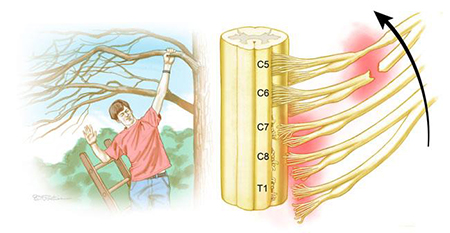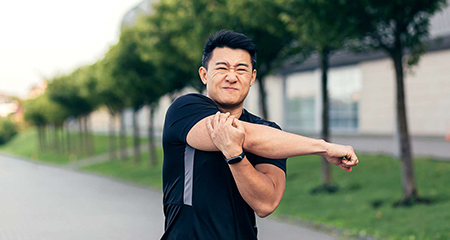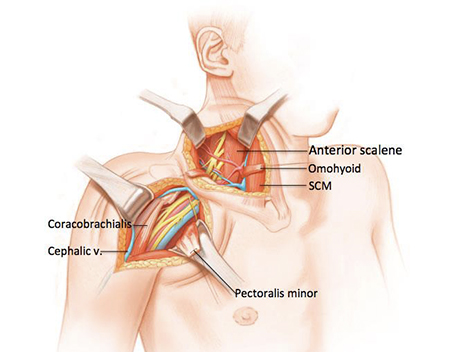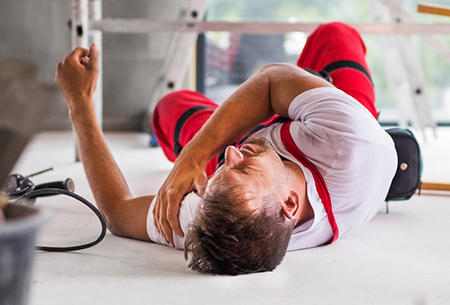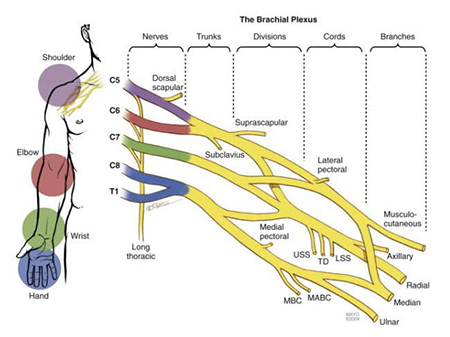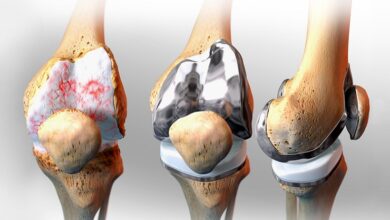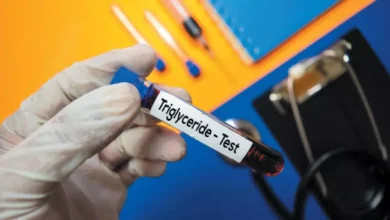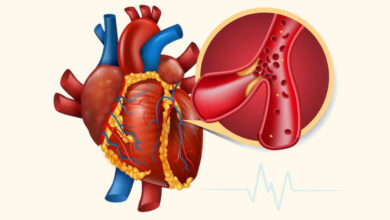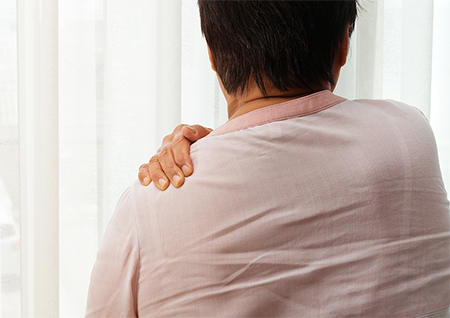
BRACHIAL PLEXUS INJURIES: SYMPTOMS, CAUSES, AND TREATMENT
Brachial plexus injuries usually occur due to trauma or damage in the neck and shoulder area. This article will investigate brachial plexus injuries’ causes, symptoms, and treatment.
INTRODUCTION
Damage to the brachial plexus is one of the most common nerve injuries among adults and children. Blows to the shoulder and neck cause brachial plexus injuries. This injury can severely restrict movement and cause severe pain around the arm and hand. This article examines brachial plexus injuries’ causes, symptoms, and treatment.
Shoulder strain is one of the causes of brachial plexus injuries.
CAUSES OF BRACHIAL PLEXUS INJURIES
Brachial plexus injuries may be caused by a variety of factors, including:
• Physical injuries: include impact, pressure, stretching, etc. These injuries may occur when increased compressive force is used in the arm or shoulder.
• Other physical injuries include injuries caused by car accidents, falling from a height, sports accidents, etc.
• Risk factors include pulling heavy, repetitive, and long-term loads and incorrect and wrong movements during exercise and daily activities.
• Diseases related to nerves: Some diseases, such as diabetic neuropathy, cancer, etc., can cause damage to the brachial plexus.
• Some other factors, such as nerve infections, kidney failure, autoimmune diseases, etc., can cause damage to the brachial plexus.
In any case, correct and timely treatment of brachial plexus injuries can lead to recovery.
SYMPTOMS OF BRACHIAL PLEXUS INJURIES
Symptoms of brachial plexus injuries include severe pain in the shoulder, arm, and hand, limited range of motion in the arm and writing, and muscle weakness around the arm and hand. In some cases, only some symptoms may be present. To correctly diagnose brachial plexus injuries, it is necessary to consult your doctor and perform the required tests.
Severe pain in the shoulder area is one of the symptoms of brachial plexus injuries.
DIAGNOSIS OF BRACHIAL PLEXUS INJURIES
Diagnosing brachial plexus injuries is usually done using physical tests that examine the movement and sensation of the arm and hand. Standard tests include nerve and muscle tests and sensory and imaging tests such as X-rays and MRIs. Your doctor may also perform other tests to diagnose brachial plexus injuries.
PREVENTION OF BRACHIAL PLEXUS INJURIES
To prevent brachial plexus injuries, you should avoid exercises and sports that give extra strength to the arm and shoulder. Also, wear a seat belt while driving. Use safety equipment if you participate in sports such as soccer, volleyball, or basketball.
Brachial plexus reconstruction surgery to treat brachial plexus injuries
TREATMENT OF BRACHIAL PLEXUS INJURIES
Treatment of brachial plexus injuries depends on the type and severity of the injury. It may include one or a combination of the following methods:
1. NON-SURGICAL TREATMENT
These treatments include rest from activities that irritate the brachial plexus, physical therapy to strengthen muscles and improve arm and hand movement, electrical muscle stimulation, massage, and anti-inflammatory medications.
2. SURGICAL TREATMENT
In some cases, non-surgical treatments may not be able to achieve complete recovery. Brachial plexus reconstruction surgery is chosen as a treatment method in these cases. In surgery, the doctor opens the patient’s arm and tries to examine the damaged nerves and reconstruct them if necessary.
3. DRUG TREATMENT
Depending on the type and severity of the injury, your doctor may prescribe pain relievers, anti-inflammatories, or other medications to help reduce pain and inflammation.
The important thing is that if you experience any of the symptoms of brachial plexus injury, it is better to see your doctor so that a more accurate diagnosis can be made about your condition and appropriate treatment can be prescribed.
THERAPEUTIC EXERCISES FOR BRACHIAL PLEXUS INJURIES
Therapeutic exercises for brachial plexus injuries include strengthening muscles, improving arm and hand movement, and reducing pain. The activities used depend on the type of injury and its severity. For therapeutic exercises, it is better to consult your doctor or physiotherapist.
Be careful to prevent the recurrence of brachial plexus injuries.
POST-TREATMENT RECOMMENDATIONS
After treatment, you should follow the exercises and recommendations of your doctor. Also, to prevent the recurrence of injuries, you should not avoid activities that give extra strength to the arm and shoulder. If the pain and movement restriction continues, you should see your doctor.
FREQUENTLY ASKED QUESTIONS ABOUT BRACHIAL PLEXUS INJURIES
1. What are brachial plexus injuries?
The brachial plexus is a set of nerves that runs from the neck to the arm and hand. Brachial plexus injuries cause limited movement and severe pain around the arm and hand.
2. What is the leading cause of brachial plexus injuries?
The leading cause of brachial plexus injuries can be pulling the arm up or down with great force. Also, car accidents, falling from a height, intense sports, diseases related to nerves, and risk factors such as pulling heavy and repetitive loads can cause brachial plexus injuries.
3. Can brachial plexus injuries be treated?
Treating brachial plexus injuries may include muscle stimulation, massage, physical exercises, medications, and, in some cases, surgery. Correct and timely treatment can lead to recovery.
4. Can brachial plexus injuries be prevented?
Yes, to prevent brachial plexus injuries, you should avoid sports and activities that put extra force on the arm and shoulder, and if in doubt, consult your doctor.
Brachial plexus or brachial nerve plexus
5. Can brachial plexus injuries cause permanent movement restriction?
In some cases, brachial plexus injuries can cause permanent movement limitations. It depends on the severity and type of injury. If the treatment is not done on time, the damage may remain permanent, and permanent movement limitations may occur.
6. Do brachial plexus injuries occur in children?
Yes, brachial plexus injuries also occur in children. Brachial plexus injuries may occur in children due to difficult childbirth, birth trauma, etc.
7. Can sports training and intense sports cause brachial plexus injuries?
Yes, doing sports and intense sports can be considered as one of the risk factors for brachial plexus injuries. To prevent brachial plexus injuries, you should avoid sports and activities that put extra force on the arm and shoulder, and if in doubt, consult your doctor.
8. Can muscle stimulation and massage be helpful in the treatment of brachial plexus injuries?
Yes, muscle stimulation and massage can be helpful as one of the treatment methods for brachial plexus injuries. These treatments can help improve blood flow and reduce pain and inflammation.
9. Is surgery necessary to treat brachial plexus injuries?
It depends on the severity and type of injury. In some cases, surgery is necessary to treat brachial plexus injuries. If non-surgical treatments are ineffective, the doctor may perform surgery and reconstruct the damaged nerves.
10. Do patients with brachial plexus injuries recover with proper treatment?
Yes, with proper treatment, patients with brachial plexus injuries can recover. Suppose the treatment is done on time and according to the severity and type of injury. In that case, it can significantly improve movement and pain around the arm and hand. However, in some cases, brachial plexus injuries can cause permanent movement limitations. In these cases, treatment may not result in significant improvement.
FINAL WORDS OF BRACHIAL PLEXUS INJURIES
Brachial plexus injuries, usually due to blows in the shoulder area, can cause limited movement and severe pain around the arm and hand. The leading cause of brachial plexus injuries can be pulling the arm up or down with great force. Treatment of brachial plexus injuries depends on the severity and type of injury. It may include muscle stimulation, massage, physical exercises, medications, and, in some cases, surgery. To prevent brachial plexus injuries, you should avoid sports and activities that put extra force on the arm and shoulder, and if in doubt, consult your doctor.
